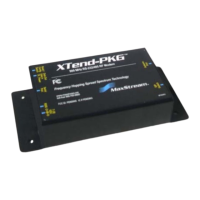9XTend-PKG-U™ USB RF Modem User’s Guide
44
4.2. Basic Communications
Basic Communications are accomplished through two sub-types:
• Broadcast - By default, XTend RF Modems communicate through Broadcast communications
and within a peer-to-peer network topology. When any modem transmits, all other modems
within range will receive the data and pass it directly to their host device.
• Addressed - If addressing parameters match are in order, received RF data is forwarded to
the DO (Data Out) buffer; otherwise, the RF data is discarded.
When using Basic Communications, any functions such as acknowledgements are handled at the
application layer by the OEM/integrator. The Broadcast Modes provide transparent communica-
tions, meaning that the RF link simply replaces a wired link.
4.2.1. Streaming Mode (Default)
Characteristics:Highest data throughput
Lowest latency and jitter
Reduced immunity to interference
Transmissions never acknowledged (ACK) by receiving module(s)
Required Parameter Values (TX modem): RR (Retries) = 0
Related Commands: Networking (DT, MK, MY), Serial Interfacing (PK, RB, RO, TT)
Recommended Use: Mode is most appropriate for data systems more sensitive to latency and/or
jitter than to occasional packet loss. For example: streaming audio or video.
Connection Sequence
Figure 4-04. Streaming Mode State Diagram (TX Module)
• Events & processes in this mode are common to all of
the other RF Modes.
• When streaming data, RB and RO parameters are only
observed on the first packet.
After transmission begins, the transmission event will con-
tinue uninterrupted until the DI buffer is empty or the
streaming limit (TT parameter) is reached. As with the first
packet, the payload of each subsequent packet includes up
to the maximum packet size (PK parameter).
The TT parameter (streaming limit) is specified by the TX
(transmitting) modem as the maximum number of bytes the
TX module can send in one transmission event. After the TT
parameter threshold is reached, the TX modem will force a
random delay of 1 to RN delay slots (exactly 1 delay slot if
RN = 0).
Subsequent packets are sent without an RF initializer since
RX (receiving) modems remain synchronized with the TX
modem for the duration of the transmission (from preceding
packet information). However, due to interference, some RX
modems may lose data (and synchronization to the TX
modem), particularly during long transmission events.
Once the TX modem has sent all pending data or has
reached the TT limit, the transmission event ends. The TX
modem will not transmit again for exactly RN delay slots if
the local (i.e. TX modem's) RN parameter is set to a non-
zero value. The RX modem(s) will not transmit for a random
number of delay slots between 0 and (RN-1) if the local (i.e.
receiving module's) RN parameter is set to a non-zero
value. These delays are intended to lessen congestion fol-
lowing long bursts of packets from a single TX modem, dur-
ing which several RX modems may have become ready to transmit.

